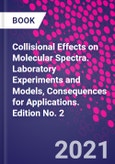Gas phase molecular spectroscopy is a powerful tool for obtaining information on the geometry and internal structure of isolated molecules and their interactions with others. It enables the understanding and description, through measurements and modeling, of the influence of pressure on light absorption, emission, and scattering by gas molecules, which must be taken into account for the correct analysis and prediction of the resulting spectra. Collisional Effects on Molecular Spectra: Laboratory Experiments and Models, Consequences for Applications, Second Edition provides an updated review of current experimental techniques, theoretical knowledge, and practical applications. After an introduction to collisional effects on molecular spectra, the book moves on by taking a threefold approach: it highlights key models, reviews available data, and discusses the consequences for applications. These include areas such as heat transfer, remote sensing, optical sounding, metrology, probing of gas media, and climate predictions. This second edition also contains, with respect to the first one, significant amounts of new information, including 23 figures, 8 tables, and around 700 references.Drawing on the extensive experience of its expert authors, Collisional Effects on Molecular Spectra: Laboratory Experiments and Models, Consequences for Applications, Second Edition, is a valuable guide for all those involved with sourcing, researching, interpreting, or applying gas phase molecular spectroscopy techniques across a range of fields.
Please Note: This is an On Demand product, delivery may take up to 11 working days after payment has been received.
Table of Contents
1. Introduction2. General Equations
3. Isolated Lines
4. Collisional Line-Mixing within clusters of lines
5. The Far Wings: beyond the impact introduction
6. Collision-induced absorption and light scattering
7. Consequences for Applications
8. Laboratory experimental techniques
9. Towards Future Research








